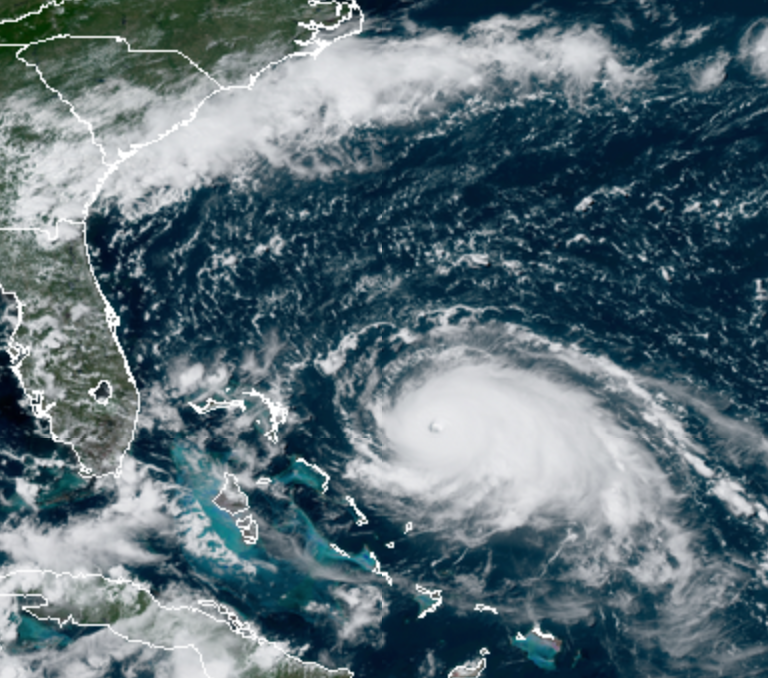Florida, Georgia, and the Carolinas were bracing for a major hurricane landfall this week as Hurricane Dorian brushed by Puerto Rico and gained strength over warm Atlantic waters. Forecast tracks were still uncertain as of Saturday, but the model consensus showed the storm slowing down near the coast of Florida over the weekend, then curving northward toward the Carolinas early next week.
“Because it isn’t for another four to seven days before Dorian will make its closest approach to this zone north of Florida, and forecasting the track has large errors so far out, it’s not possible to pinpoint if and where the storm will make landfall and how close it will track to the coast,” noted the Washington Post (see: “‘Extremely dangerous’ Hurricane Dorian barrels toward Southeast U.S. with a forecast path perilously close to Florida,” by Jason Samenow).
As usual, the Weather Underground Category 6 blog provided some of the best coverage of the looming hurricane. Severe weather experts Bob Henson and Jeff Masters provided blow-by-blow updates on the storm’s progress and likely development (see: “Dorian Slams Virgin Islands; Likely to Approach Florida as a Major Hurricane,” by Bob Henson). “Bottom line: expect Dorian to undergo a round of rapid intensification sometime Thursday or Friday, which will bring it to at least Category 3 strength as it approaches the Southeast U.S. coast on Saturday,” wrote Henson on Thursday. In a Saturday update (see: “Uncertainty Widens for Southeast Impacts from Extremely Dangerous Dorian,” Henson wrote, “The entire Southeast U.S. coast from central Florida to northern North Carolina is in the NHC cone of uncertainty for Dorian, and is at risk of a devastating storm surge, damaging winds, and extreme flooding rains.”
“Central Floridians have started preparing for the hurricane, which could hit the area on Monday,” reported the Orlando Sentinel on Thursday (see: “Hurricane Dorian could be worst storm to hit Central Florida in three decades if current track holds, meteorologist says,” by Tiffini Theisen, David Harris and Richard Tribou). “Some grocery stores were already seeing their stocks of bottled water and other supplies dwindle, with a Publix spokesman saying the chain was experiencing ‘impact buying’ from customers. Generators, tarps, batteries and battery-powered weather radios were being snapped up at Home Depot stores.” Florida Governor Ron DeSantis declared a state of emergency on Wednesday.
Days before the storm’s expected landfall, builders in Palm Beach were busy preparing jobsites to withstand high winds, reported the Palm Beach Daily News (see: “Hurricane Dorian: Builders rush to secure Palm Beach construction sites to prevent flying debris,” by Darrell Hofheinz). “The staff at Town Hall was also taking no chances,” the paper reported. “The town code doesn’t technically require construction crews to swing into action until an official storm watch has been issued. But on Wednesday — the day before a hurricane watch was expected to be issued for South Florida — building officials distributed notices to contractors detailing just what steps they must take to prepare properties for Dorian’s wind and rain. Those who failed the task could face penalties, according to the code.”
Contractors told the Daily News that they were removing newly installed exterior doors and bringing them inside to protect them, replacing the doors with plywood. Another big concern was clay or concrete roofing tiles that had been loaded on the roof but not yet installed, the paper noted; in that case, one contractor said, he was asking roofers to remove the tiles and store them at their own business locations.
But by Sunday morning, with forecast tracks showing the storm curving away from the Florida coast, tensions were dropping on the peninsula. Still, a Florida landfall remains a possibility, and government officials were advising Florida residents to keep their guard up, reported USA Today (see: “Dorian, packing near 150 mph winds, on track to skirt Florida coast,” by Doug Stanglin). “Everyone’s waking up and saying, ‘Whoa, it’s a little farther east, maybe things are OK.’ But we’ve got to be careful at this time,” said Ken Graham, director of the National Hurricane Center in Miami, on Saturday morning.
